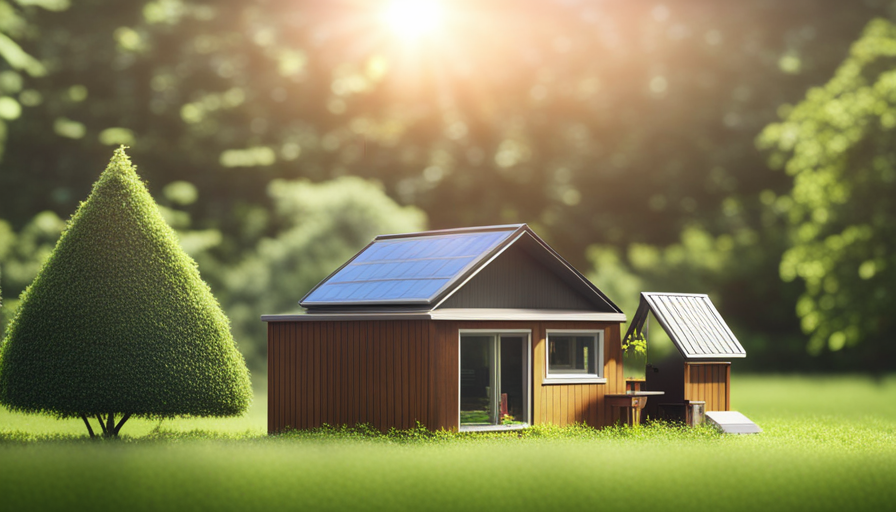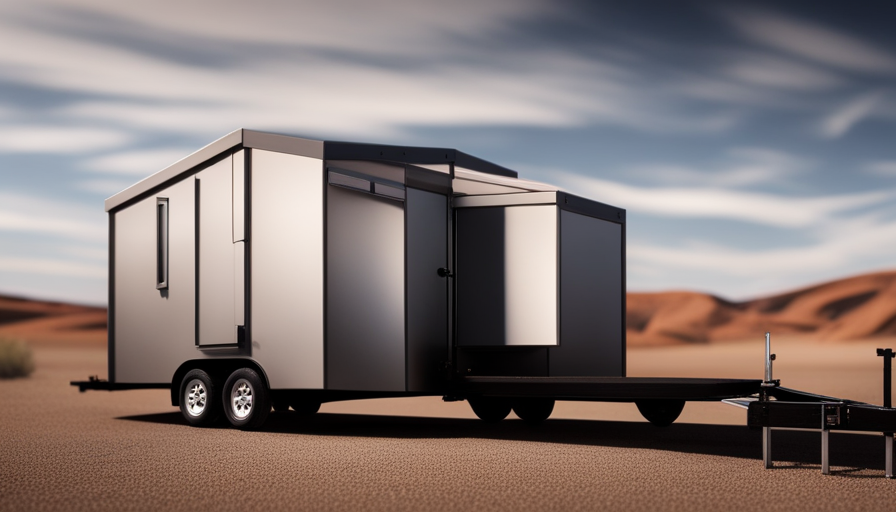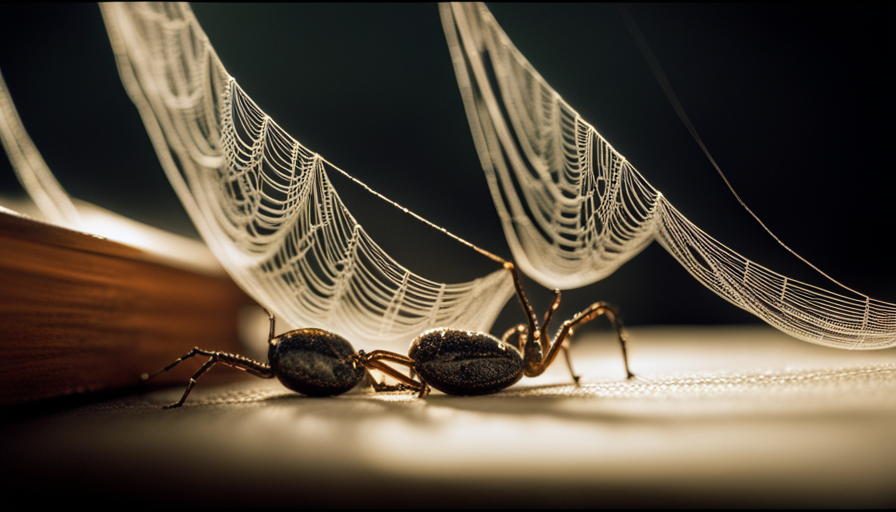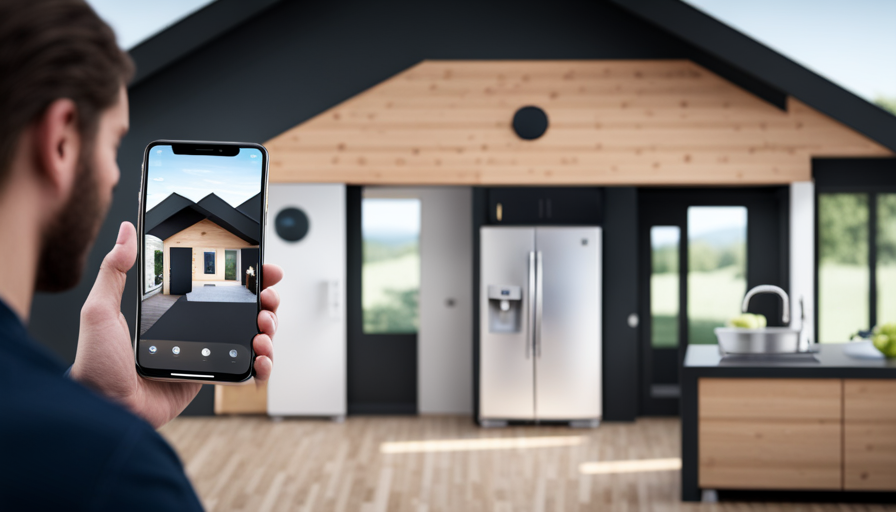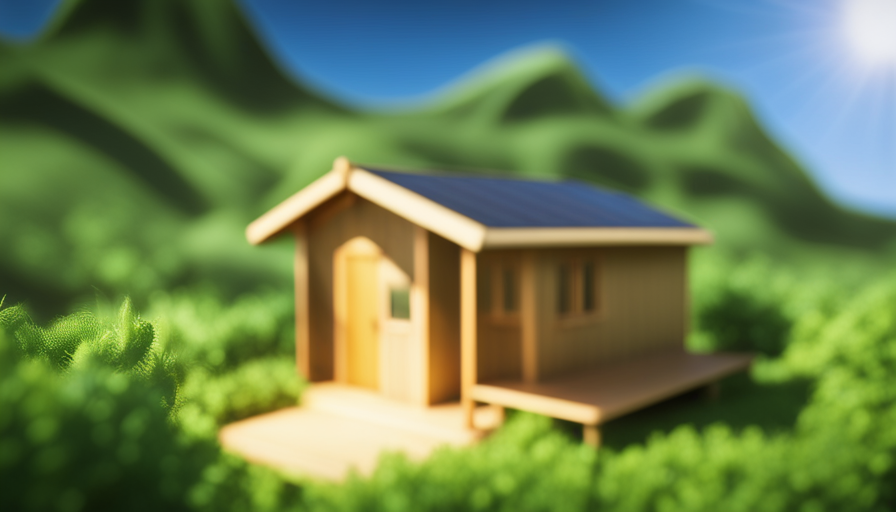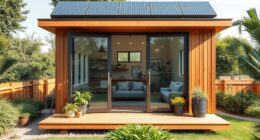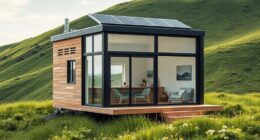The saying, “Good things come in small packages,” accurately captures the appeal of tiny houses. These small homes have captured our attention and sparked a movement towards simpler, more environmentally-friendly living. But, the lingering question is: Just how energy-efficient are these compact dwellings?
In this article, we delve into the world of tiny house energy consumption, shedding light on the kilowatt usage that powers these homes. With a focus on data-driven analysis and technical insights, we explore the factors that affect energy efficiency in tiny houses.
From understanding how solar power and renewable energy options can play a role in reducing kilowatt usage to exploring off-grid versus on-grid options, we leave no stone unturned in our quest for knowledge.
We also take a closer look at water heating and plumbing efficiency as well as heating and cooling systems tailored specifically for tiny houses. Additionally, we provide practical tips for reducing energy consumption without sacrificing comfort or convenience.
So join me on this journey as we uncover the secrets behind how many kilowatts a tiny house really uses. Let’s embrace sustainable living together!
Key Takeaways
- Tiny houses prioritize energy efficiency and sustainability, focusing on factors such as solar power, insulation, water heating, and heating/cooling systems.
- Investing in energy-efficient appliances and insulation techniques can significantly reduce kilowatt usage in tiny houses.
- Maximizing natural lighting and utilizing renewable energy options like solar panels, wind power, and hydroelectricity can further decrease kilowatt consumption.
- Choosing alternative energy sources, such as off-grid options with battery storage systems or connecting to the grid with net metering, allows for sustainable and convenient power supply in tiny houses.
Understanding Energy Efficiency in Tiny Houses
If you’re curious about how much energy a tiny house consumes, you’ll be amazed at the efficiency it achieves! Tiny houses are designed to maximize energy savings through the use of various strategies and technologies.
One key aspect is the incorporation of energy-saving appliances. These appliances are specifically designed to consume less electricity while still providing the necessary functionality for daily living. For example, tiny houses often utilize compact refrigerators and efficient heating and cooling systems that have low power requirements.
In addition to energy-saving appliances, insulation plays a vital role in reducing kilowatt usage in tiny houses. Proper insulation helps retain heat during winter months and keeps the interior cool during summer months, thereby minimizing the need for excessive heating or cooling. Insulation can be done using materials such as spray foam or cellulose that provide excellent thermal resistance.
To further enhance energy efficiency, tiny house owners can follow specific insulation tips. For instance, sealing all gaps and cracks around windows and doors prevents air leakage and ensures maximum insulation effectiveness. Additionally, installing double-pane windows with insulated frames helps minimize heat transfer between indoors and outdoors.
By incorporating these energy-saving appliances and implementing effective insulation techniques, tiny houses achieve remarkable levels of energy efficiency. However, there are other factors affecting kilowatt usage in these homes that will be discussed in subsequent sections.
Factors Affecting Kilowatt Usage in Tiny Houses
When it comes to powering a small living space, you’ll want to consider various factors that can impact the amount of electricity needed. In the case of tiny houses, there are specific elements that can affect kilowatt usage. Here are four key considerations:
-
Energy-saving appliances: Opting for energy-efficient appliances can significantly reduce kilowatt usage in a tiny house. Appliances with an ENERGY STAR rating consume less power and are designed to minimize energy waste.
-
Insulation techniques: Proper insulation is crucial for maintaining a comfortable temperature inside a tiny house without relying heavily on heating or cooling systems. By utilizing effective insulation techniques such as spray foam or double-pane windows, heat loss or gain can be minimized, reducing the need for excessive electrical use.
-
Natural lighting: Maximizing natural light through well-placed windows and skylights reduces the need for artificial lighting during the day, consequently lowering kilowatt consumption.
-
Efficient heating and cooling systems: Installing energy-efficient HVAC systems like mini-split air conditioners and programmable thermostats allows precise control over temperature regulation while minimizing electricity usage.
Considering these factors when designing and outfitting a tiny house will help optimize energy efficiency and decrease kilowatt consumption.
In the next section, we will explore average kilowatt usage in tiny houses without losing sight of these essential considerations.
Average Kilowatt Usage in Tiny Houses
By optimizing energy-efficient appliances, insulation techniques, natural lighting, and heating/cooling systems in your tiny house, you can significantly reduce your kilowatt usage and feel empowered to make a positive environmental impact. Understanding energy usage is crucial in minimizing energy wastage and maximizing efficiency.
On average, tiny houses use around 2-4 kilowatts per day, depending on various factors such as the size of the house, the number of occupants, and their lifestyle choices.
To minimize your kilowatt usage further, consider investing in energy-efficient appliances that are specifically designed for smaller spaces. These appliances consume less power while still providing the functionality you need. Additionally, proper insulation is essential for maintaining a comfortable temperature inside your tiny house without relying heavily on heating or cooling systems. By preventing heat loss during winter and heat gain during summer through effective insulation techniques, you can reduce the amount of energy needed to keep your home at a comfortable temperature.
Maximizing natural lighting is another strategy for decreasing kilowatt usage. Large windows and skylights allow ample sunlight to enter your tiny house during the day, reducing the need for artificial lighting. Furthermore, utilizing renewable energy options like solar power can significantly offset your kilowatt consumption. Transitioning into the subsequent section about ‘solar power and renewable energy options,’ these alternatives provide sustainable sources of electricity that can further reduce reliance on traditional power grids while minimizing the carbon footprint.
Solar Power and Renewable Energy Options
When it comes to powering a tiny house, there are various options for utilizing renewable energy. One of the most popular choices is installing solar panels, which can generate electricity from sunlight.
Additionally, wind power and hydro power can also be considered as viable alternatives for generating clean energy in a tiny house.
Installing Solar Panels
To maximize the energy efficiency of your tiny house, you’ll want to consider installing solar panels. Solar panel installation offers numerous benefits such as reducing electricity costs and minimizing environmental impact. By harnessing the power of the sun, you can generate clean and renewable energy that can be used to power your appliances and systems.
To help you understand the process of installing solar panels, here is a visual representation:
| Steps | Description |
|---|---|
| 1 | Assess your energy needs and determine the number of panels required. |
| 2 | Choose the right type of solar panels for your tiny house. |
| 3 | Install mounting brackets or frames on a suitable rooftop area. |
| 4 | Connect the panels to an inverter system for converting direct current (DC) into alternating current (AC). |
By following these steps, you can efficiently install solar panels on your tiny house and start enjoying the benefits of renewable energy. In the subsequent section about utilizing wind or hydro power, we will explore alternative options for further maximizing your tiny house’s energy efficiency without relying solely on solar power.
Utilizing Wind or Hydro Power
If you want to truly maximize your energy efficiency, don’t forget to consider utilizing wind or hydro power in your tiny house. Both wind power and hydroelectricity are viable options for generating electricity in a sustainable manner.
Wind power involves harnessing the natural force of wind using turbines to convert it into electrical energy. By installing a small wind turbine on your property, you can generate clean and renewable electricity to power your tiny house.
Hydroelectricity, on the other hand, utilizes flowing water to produce electricity. If you have access to running water nearby, you can set up a small-scale hydroelectric system that will provide a consistent and reliable source of power for your needs.
Incorporating these alternative energy sources into your tiny house design will greatly reduce your reliance on traditional grid-based electricity.
Now let’s move on to discussing the off-grid vs. on-grid options for powering your tiny house without compromising sustainability and convenience.
Off-Grid vs. On-Grid Options
When it comes to off-grid vs. on-grid options, there are a couple of key points to consider. A battery storage system allows you to store excess energy generated by your renewable energy sources, such as solar panels, for use during times when the sun is not shining or the wind is not blowing. This can provide you with a reliable source of power even when disconnected from the grid.
On the other hand, connecting to the grid allows you to sell any excess energy back to your utility company, providing potential financial benefits and ensuring a backup power source in case your renewable energy system cannot meet all of your electricity needs.
Battery Storage Systems
Although battery storage systems can be a game-changer for tiny house owners, they need to consider the kilowatts their homes consume. Battery efficiency is crucial in ensuring that the energy stored in the batteries lasts as long as possible.
It is essential to choose alternative energy sources such as solar panels or wind turbines with high conversion rates to maximize the charging of the batteries. Additionally, monitoring and managing power usage within the tiny house is essential to optimize battery performance.
By using energy-efficient appliances and implementing smart home technologies, homeowners can minimize their electricity consumption and extend battery life. However, it’s important to note that even with efficient battery storage systems, connecting to the grid may still be necessary for those times when there is insufficient renewable energy generation or increased power demands.
Connecting to the Grid
Connecting to the grid is a practical solution for tiny house owners to ensure a reliable power source during times of insufficient renewable energy generation or increased power demands.
When connecting to the grid, tiny house owners have several energy supply options available to them. They can choose between a net metering system, which allows excess electricity generated by their tiny house to be supplied back to the grid in exchange for credits, or they can opt for a time-of-use plan where electricity rates vary depending on the time of day.
Additionally, some utility companies offer special programs and incentives specifically designed for small-scale residential customers like tiny houses. These options provide flexibility and convenience while ensuring a steady flow of electricity.
Implementing energy conservation strategies such as efficient appliances and smart energy management systems can further optimize power usage in tiny houses without compromising comfort or functionality.
Energy Conservation Strategies
One effective way to conserve energy in a tiny house is by using LED light bulbs instead of traditional incandescent ones. LED bulbs are more energy-efficient, consuming significantly less electricity while providing the same level of brightness. This small change can make a big difference in reducing overall energy consumption.
To further enhance energy conservation in a tiny house, consider investing in energy-saving appliances. These appliances are designed to use less power without compromising functionality. Additionally, implementing insulation techniques such as insulating walls and windows can help maintain a comfortable temperature inside the tiny house without relying heavily on heating or cooling systems.
Other strategies for conserving energy include:
- Installing programmable thermostats to optimize heating and cooling schedules.
- Using natural lighting during daylight hours to minimize reliance on artificial lights.
- Maximizing natural ventilation through well-placed windows and vents.
- Implementing smart home automation systems that allow remote control of various devices, optimizing their usage patterns.
By adopting these energy conservation strategies, you can significantly reduce your reliance on grid power and minimize your carbon footprint. Transitioning into the subsequent section about water heating and plumbing efficiency, it’s important to consider similar approaches for optimizing water usage within a tiny house.
Water Heating and Plumbing Efficiency
Water heating and plumbing efficiency are crucial aspects of energy conservation in a tiny house. One key point to consider is the use of tankless water heaters, which provide hot water on demand and eliminate the need for a storage tank.
Additionally, installing low-flow fixtures can significantly reduce water consumption, while practicing water-saving habits such as shorter showers and turning off faucets when not in use further optimize efficiency.
Tankless Water Heaters
Tankless water heaters are a great addition to any tiny house because they provide hot water on demand without taking up valuable space. One of the main benefits of a tankless water heater is its energy efficiency. Unlike traditional water heaters that constantly heat and store large amounts of water, tankless units only heat the water when it’s needed. This eliminates standby heat loss and can result in significant energy savings.
Additionally, tankless water heaters have a longer lifespan compared to traditional ones, reducing the need for frequent replacements.
When it comes to installation, tankless water heaters are relatively easy to set up in tiny houses due to their compact size. They can be mounted on walls or even installed outdoors if space is limited inside the house. However, proper venting and adequate electrical supply must be considered during installation.
Transitioning into low-flow fixtures and water-saving practices, it’s important to complement your tankless water heater with these measures for maximum efficiency in a tiny house setup.
Low-Flow Fixtures and Water-Saving Practices
In my previous section, I discussed the benefits of tankless water heaters in a tiny house. Now, let’s move on to the current subtopic: low-flow fixtures and water-saving practices. These are essential components for maintaining an efficient and sustainable water system in a tiny house.
-
Low-flow fixture benefits: Installing low-flow showerheads and faucets helps conserve water by reducing the flow rate without compromising performance.
-
Water-saving techniques: Implementing simple practices like turning off the tap while brushing your teeth or collecting rainwater for non-potable uses can significantly reduce water consumption.
-
Using dual-flush toilets: This innovative feature allows you to select between a full flush or a partial flush, depending on your needs, resulting in significant water savings.
-
Greywater recycling systems: By treating and reusing greywater from sinks, showers, and washing machines for irrigation purposes, you can minimize overall water usage.
Transitioning into heating and cooling in tiny houses, it’s crucial to consider energy-efficient options that’ll comfortably maintain temperature control without excessive power consumption.
Heating and Cooling in Tiny Houses
Air conditioning in tiny houses is like trying to cool a volcano with a handheld fan. Due to their small size and limited insulation, maintaining a comfortable temperature can be quite challenging. However, there are energy efficient solutions and alternative heating methods that can help regulate the temperature in these compact spaces.
One effective way to heat a tiny house is by using a radiant floor heating system. This method distributes heat evenly throughout the space, minimizing energy loss. Additionally, installing high-quality insulation in walls, floors, and roofs can significantly reduce heat transfer and keep the interior warm during colder months.
On the other hand, cooling options for tiny houses are more limited. Traditional air conditioning units consume substantial amounts of electricity and may not be practical for off-grid living or those seeking minimal energy consumption. Instead, utilizing natural ventilation through windows and strategically placed fans can help circulate air and provide some relief from hot temperatures.
Here is a breakdown of common heating and cooling methods used in tiny houses:
| Heating Methods | Cooling Methods | Energy Consumption |
|---|---|---|
| Radiant Floor Heating | Natural Ventilation | Moderate |
| Insulation | Fans | Low |
By implementing these energy-saving techniques, tiny homeowners can create a comfortable living environment while reducing their overall energy consumption. In the next section, we will explore additional tips for further reducing energy usage in tiny houses without compromising comfort or convenience.
Tips for Reducing Energy Consumption
Transform your tiny living space into an energy-efficient haven with these simple tips for reducing consumption and minimizing your carbon footprint. By implementing these strategies, you can significantly decrease the amount of kilowatts your tiny house uses while still enjoying a comfortable living environment.
One effective way to reduce energy consumption is by investing in energy-saving appliances. These appliances are designed to use less electricity without compromising their functionality. Look for Energy Star certified products, as they meet strict standards for efficiency and can help you save up to 30% on your energy bills.
Another tip for reducing energy consumption is to optimize insulation in your tiny house. Proper insulation prevents heat transfer, keeping your home warm in winter and cool in summer. Consider using eco-friendly insulation materials like recycled denim or cellulose, which have excellent thermal properties and reduce the need for excessive heating or cooling.
Additionally, make it a habit to turn off lights and unplug electronics when not in use. Even though they may seem small, these actions can add up over time and contribute to significant energy savings.
Embracing sustainable living in tiny houses involves taking steps towards reducing energy consumption through the use of efficient appliances, optimizing insulation, and practicing mindful habits like turning off unused lights and electronics. By making these changes, you can create an environmentally friendly home while enjoying all the benefits of tiny living.
Conclusion: Embracing Sustainable Living in Tiny Houses
Create an eco-friendly haven in your tiny living space by embracing sustainable practices and reducing your carbon footprint. One of the key ways to achieve this is by using energy efficient appliances. These appliances are designed to consume less electricity, thereby reducing the overall energy consumption of your tiny house.
To further illustrate the benefits of embracing sustainable living in tiny houses, let’s take a look at a comparison between traditional appliances and their energy-efficient counterparts. The table below showcases the average power consumption of common household appliances:
| Appliance | Traditional (kW) | Energy Efficient (kW) |
|---|---|---|
| Refrigerator | 1.2 | 0.4 |
| Air Conditioner | 3 | 1 |
| Washer | 0.8 | 0.2 |
| Lighting | 0.06 | 0.01 |
As you can see from the table, energy efficient appliances significantly reduce power consumption compared to their traditional counterparts. This not only saves on electricity bills but also helps conserve resources and reduces greenhouse gas emissions.
By choosing energy efficient appliances for your tiny house, you can greatly contribute to creating a sustainable living environment while enjoying the benefits of lower energy costs. So why not make the switch today and start making a positive impact on both your wallet and the planet?
Frequently Asked Questions
Can I use a tiny house off-grid without any connection to the electrical grid?
Yes, a tiny house can be used off-grid without any connection to the electrical grid. Off-grid living involves relying on alternative power sources such as solar panels, wind turbines, or generators. These sources generate electricity that can be stored in batteries for use when needed. By harnessing renewable energy and efficiently managing power consumption, it’s possible to live sustainably and independently without relying on the traditional electrical grid infrastructure.
What are the benefits of using solar power in a tiny house?
Using solar power in a tiny house provides numerous benefits, including significant cost savings and environmental sustainability.
Did you know that the average American household spends around $1,500 annually on electricity? By harnessing the sun’s energy, a tiny house can drastically reduce or even eliminate this expense.
Furthermore, solar power is a clean and renewable source of energy, reducing carbon emissions and helping to combat climate change.
How can I make my tiny house more energy-efficient?
To make my tiny house more energy-efficient, I can start by focusing on insulation tips and using energy-efficient appliances.
Properly insulating the walls, roof, and floor will help minimize heat loss in winter and heat gain in summer.
Additionally, choosing energy-efficient appliances like refrigerators, dishwashers, and HVAC systems can significantly reduce electricity consumption.
These actions will lead to a decrease in overall energy usage and make my tiny house more sustainable.
Is it possible to heat and cool a tiny house without using a lot of electricity?
To heat and cool a tiny house without consuming excessive electricity, there are various options available.
Firstly, consider passive heating and cooling techniques such as strategic window placement, insulation, and shading to optimize temperature control.
Additionally, energy-efficient appliances like mini-split HVAC systems or geothermal heat pumps can significantly reduce power consumption.
By employing these methods and utilizing energy-efficient appliances, it’s possible to maintain comfortable temperatures in a tiny house while minimizing electricity usage.
Are there any government incentives or rebates available for installing renewable energy systems in a tiny house?
Government incentives and rebates are available for installing renewable energy systems in a tiny house. These incentives encourage the adoption of sustainable practices and can offset the costs associated with renewable energy installation. By taking advantage of these programs, tiny house owners can reduce their carbon footprint while also saving money in the long run.
It’s important to research and understand the specific incentives and requirements offered by your local government or utility company to take full advantage of these opportunities.
Conclusion
In conclusion, living in a tiny house allows for an eco-friendly and energy-efficient lifestyle. These compact dwellings minimize energy consumption while maximizing sustainability, with an average kilowatt usage of around 2-3 kilowatts. By harnessing the power of solar panels and utilizing renewable energy options, tiny homeowners can reduce their carbon footprint even further.
Additionally, efficient water heating and plumbing systems, as well as smart heating and cooling solutions, contribute to minimizing energy waste. Embracing sustainable living in a tiny house isn’t just practical, but it also gives you the freedom to live more consciously and comfortably within your cozy abode.
So why not take the leap into this pint-sized revolution? It’s time to downsize your worries and maximize your eco-consciousness!
Hi, I’m Emma. I’m the Editor in Chief of Tiny House 43, a blog all about tiny houses. While tree houses are often associated with childhood, they can be the perfect adult retreat. They offer a cozy space to relax and unwind, surrounded by nature. And since they’re typically built on stilts or raised platforms, they offer stunning views that traditional homes simply can’t match. If you’re looking for a unique and romantic getaway, a tree house tiny house might just be the perfect option.
